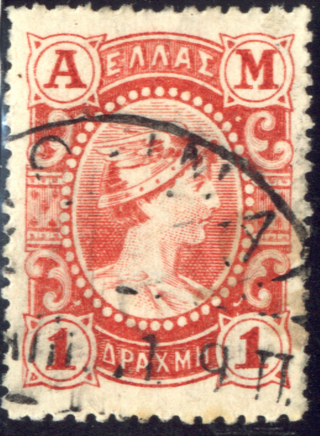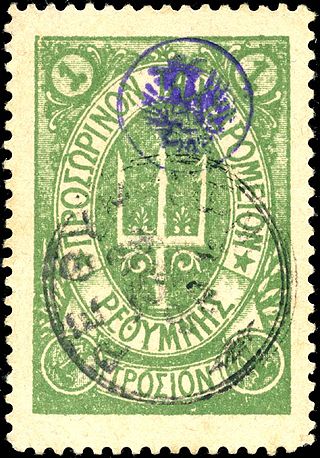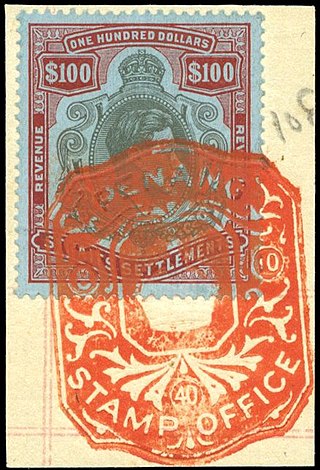
This is a survey of the postage stamps and postal history of Crete .

This is a survey of the postage stamps and postal history of Crete .
Ottoman stamps were used in Crete until 1898 and franked Letters are known since 1871. [1] [ clarification needed ]
This section needs additional citations for verification .(February 2020) |

In 1898 Crete obtained autonomy under Ottoman suzerainty, and was garrisoned by an international military force from Britain, France, Italy and Russia, who had intervened against Ottoman control to grant autonomy to the island,
The first stamps of the independent postal service in Crete were issued on 1 March 1900 (Julian calendar). [2] The first series of nine stamps featured images of Hermes, Hera, King Minos, Talos and a portrait of Prince George, who was the high commissioner of the island. The values are 1 lepton, 5 lepta, 10 lepta, 20 lepta in red colour, 25 lepta, 50 lepta in lilac colour, 1 drachma, 2 drachma and 5 drachma. The lower values up to 20 lepta have no overprint. The values from 25 lepta to 5 drachma have a red overprint or a black overprint with the word ΠΡΟΣΩΡΙΝΟΝ in small letters or no overprint. [3] First day cancels exist only on the lower values and the higher values with red overprint. The first cancel on a stamp with black overprint is "XANIA 3 MAPT 1900"[ clarification needed ] on a 2 drachma stamp.
The higher values without overprint were at first used only as revenue stamps. Some of these "revenues" were cancelled (without permission) in post offices. The first cancel on a stamp without overprint and no sign of a revenue might be "XANIA NOEM 1900" on a 5 drachma stamp.
First day cancels are known from the main post offices in Chania (ΧΑΝΙΑ), Rethymnon (ΡΕΘΥΜΝΟΝ) and Heraklion (ΗΡΑΚΛΕΙΟΝ) and from the port of Sitia (ΛΙΜΗΝ ΣΗΤΕΙΑΣ). There should have been 20 other post offices at that time, but for some of them there is no proof that they opened before 1901. One in Kalochorion was closed in May 1900, [4] so that fewer than five items cancelled with this postmark are known. The offices in Georgioupolis and Vokoulies were closed in spring 1901. Fewer than ten items cancelled with the Georgioupolis postmark are known; the Vokoulies cancels are seldom seen but not rare and forgeries exist.
In July 1900 the 20 lepta stamp in orange colour and the 50 lepta in ultramarine colour were ordered, both without overprint. One 50 lepta is cancelled "ΗΡΑΚΛΕΙΟΝ" in "ΑΥΓ 1900", although Greek stamp catalogues list the issue of both stamps in January 1901.
In December 1901 the 25 lepta with a black overprint "ΠΡΟΣΩΡΙΝΟΝ" in large letters was issued.
The 20 lepta orange overprinted with two black 5 in the lower corners was issued circa November 1904. The first known cancel on this stamp is "18 NOEM 1904".


In February 1905, the second series was released. The series depicted Artemis, Britomartis, infant Cydon suckling a female Cretan hound, Triton, Ariadne, as well as the ruins of the Palace of Knossos and the Arcadia Monastery against the backdrop of Mount Ida.[ citation needed ]
In September 1908, after the Cretan deputies unilaterally declared union with Greece, the stamps of the previous issues were overprinted "ΕΛΛΑΣ" ("Greece").[ citation needed ]
At the end of the 19th and the beginning of the 20th centuries, five countries operated post offices on the territory of Crete. Britain and Russia issued stamps inscribed in Greek, while France and Italy used their own stamps overprinted with the name of the island. [5]
In February 1881, while Crete was still a part of the Ottoman Empire, Greek post offices opened in the three big cities of the island, Chania, Rethymnon and Heraklion. These Greek post offices were consulate departments and they operated until the end of 1881, just for eight or nine months, using Greek stamps with designs including large Hermes heads. Due to the very short period that these services operated in Crete, the postal items, stamps and especially letters, are very rare.
The stamp for the russian post offices in Crete in the following gallery is a forgery. The type of forgery is described by Feenstra. [1]
Crete became part of Greece in 1913 and Greek stamps have been used on the island since 9 December 1912 in Julian Calendar. [3] [ clarification needed ]. Remaining Cretan stamps were overprinted and issued in Greece in 1923. [2]
Famous collectors of Cretan postal history include the late Dr. Angelos C. Papaioannou and Takis Karatzas from Greece but also Gunter Rhensius [6] and Johann Ulrich Schmitt from Germany and Rienk Feenstra from the Netherlands. Currently, the probably largest and most complete collection of Cretan postal history is the one compiled by Dr. Manolis Mylonakis, but there must be a handful further large collections.

Austria and other European nations maintained an extensive system of post offices in the Ottoman Empire, typically motivated by the unreliable postal system of the Ottomans.

Greece's first postal service was founded in 1828, at the time of Greek independence from the Ottoman Empire. This initial service continued mail delivery and, later, the issuing of postage stamps until 1970. It was then succeeded by the Hellenic Post S.A., which remains Greece's official postal provider. The first Greek stamps were issued in 1861; by then, the postal service had expanded to operate 97 branches.

The French post offices in Crete were among a collection of post offices maintained by foreign countries during the late 1800s/early 1900s, after Crete had broken away from the Ottoman Empire, and until 1914 after Crete united with Greece in 1913. The offices were in Chania LA CANEE Rethymnon RETHYMNO Heraklion CANDIE Sitia SITIA Ierapetra HIERAPETRA and Agios Nikolaos SAN NICOLO; the last three were already closed end of 1899
This article provides an overview of the Austrian post-offices presence in Crete and the use of French currency on Austrian stamps in the Ottoman Empire.
The postal history of Northern Epirus, a region in the western Balkans, in southern modern Albania, comprises two periods; 1912–1916 and 1940-41. Northern Epirus was under Greek administration during the First Balkan War (1912–1913), but it was then awarded to the newly founded Albanian state by the Florence Protocol (1913). During this period, Greek stamps were used. Greece withdrew from the region in early 1914. The people of Epirus were unwilling to be part of Albania, though, and launched a revolution. Under a provisional government, the independent Northern Epirus was formed in February 1914 and it eventually managed to gain full autonomy under nominal Albanian sovereignty, according to the Protocol of Corfu. Northern Epirus operated its own postal service and issued postage stamps, both official and unofficial, during that year.

The Russian post offices in Crete were established by Russia in the area of Crete it occupied as part of the joint occupying force that arrived in 1898.
Rienk Feenstra (1920–2005) was an international expert in Greek philately, writing and editing key reference books in this area, especially on the stamps and postal history of Crete. He was chairman of the Hellenic Philatelic Society of Netherlands for 6 years and then its Honorary Chairman. He was awarded the Resistance Medal, was a knight of the Order of Orange-Nassau and received numerous awards for his philatelic writing.
Each "article" in this category is a collection of entries about several stamp issuers, presented in alphabetical order. The entries are formulated on the micro model and so provide summary information about all known issuers.
Each "article" in this category is a collection of entries about several stamp issuers, presented in alphabetical order. The entries are formulated on the micro model and so provide summary information about all known issuers.
Each "article" in this category is a collection of entries about several stamp issuers, presented in alphabetical order. The entries are formulated on the micro model and so provide summary information about all known issuers.
Each "article" in this category is a collection of entries about several stamp issuers, presented in alphabetical order. The entries are formulated on the micro model and so provide summary information about all known issuers.

Souda Bay is a bay and natural harbour near the town of Souda on the northwest coast of the Greek island of Crete. The bay is about 15 km long and only two to four km wide, and a deep natural harbour. It is formed between the Akrotiri peninsula and Cape Drapano, and runs west to east. The bay is overlooked on both sides by hills, with a relatively low and narrow isthmus in the west near Chania.

In general, philatelic fakes and forgeries are labels that look like postage stamps but have been produced to deceive or defraud. Learning to identify these can be a challenging branch of philately.

The postal history of Turkey and its predecessor state, the Ottoman Empire, dates to the 18th century when foreign countries maintained courier services through their consular offices in the Empire. Although delayed in the development of its own postal service, in 1863 the Ottoman Empire became the second independent country in Asia to issue adhesive postage stamps, and in 1875, it became a founding member of the General Postal Union, soon to become the Universal Postal Union. The Ottoman Empire became the Republic of Turkey in 1923, and in the following years, its postal service became more modernized and efficient and its postage stamps expertly designed and manufactured.

This is a survey of postage stamps and postal history of the German colonies and part of the postage stamps and postal history of Germany, as well as those of the individual countries and territories concerned.

This is a survey of the postage stamps and postal history of Lebanon, formerly known as Liban.

The Greek god Hermes, messenger of the Gods in the Greek mythology, is the representation chosen, in 1860, by the Kingdom of Greece to illustrate its first postal stamps.

Malaysia first issued revenue stamps as the Straits Settlements in 1863, and continues to do so to this day. Over the years, a number of entities in modern Malaysia have issued revenue stamps.
British post offices in Crete provided the postal service in the territory of the island of Crete. Stamps inscribed in Greek were used in the British sphere of administration (Heraklion) during the Great Powers occupation of the island in 1898–1899.
This is a survey of the postage stamps and postal history of Mount Athos.
{{cite book}}: CS1 maint: location missing publisher (link)